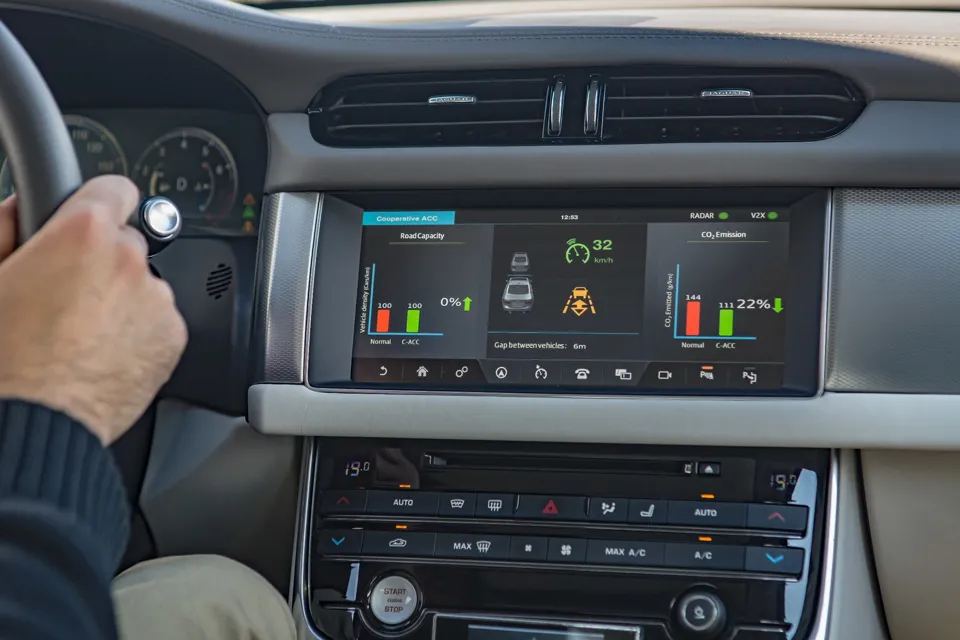Jaguar Land Rover (JLR) believes the popular term ‘driverless’ to describe autonomous vehicle technology is giving customers the impression they won’t be in control of their cars.
The manufacturer’s group strategy director Adrian Hallmark, speaking at a new technology showcase, insists the driver will remain in ultimate control of JLR products.
He told AM sister title Fleet News: “Autonomous technologies will instead work in the background to assist and enhance them.”
Cars will become safer not because they are driving themselves, but because the driver is supported by a plethora of unobtrusive new features.
“Technology will help improve traffic flow and air quality, reduce congestion and reduce the potential for accidents,” Hallmark added.
With fleet duty of care obligations in mind, this focus is already introducing safety-enhancing autonomous technologies to JLR products even before fully-autonomous technology and legislation is finalised.
New technologies such as Roadwork Assist – demonstrated to Fleet News in a Jaguar XE – uses the forward-facing stereo camera to gently and accurately guide the car through narrow roadworks.
It detects cones and barriers, centralising the vehicle between them.
The system is the first step in fully autonomous driving through roadworks, says JLR.
The stereo camera is also used for an Overhead Clearance Assist function, which measures clearances up ahead to determine if the car will fit. It can be programmed to account for bicycles and roof boxes.
Safe Pullaway helps prevent rear-end accidents at roundabout junctions by stopping cars driving into the vehicle in front (good if the driver is concentrating on looking for a gap rather than the car ahead).
A stereo camera is already standard on many JLR products: adding on this extra functionality is relatively easy.
Car-to-car communications are in development too, using a vehicle-to-infrastructure and vehicle-to-vehicle communications technology called DSRC, or dedicated short-range communications, in combination with high-speed wireless technology.
JLR is partnering with Visteon, Siemens, Huawei, Vodafone, Highways England and others to carry out real-world trials on a 41-mile connected car route around Coventry and Warwickshire, beginning later this year.
Research will focus on how to make sure this technology is not confusing for the driver and build confidence in it. Drivers will only trust autonomous technology when it is able to operate just as they would.
JLR will also use the connected car corridor to demonstrate autonomous technology to legislators and other key stakeholders, such as fleet operators.
The company’s Over The Horizon Warnings could offer in-car alerts about hazards ahead (and even indicate if the car ahead is suddenly braking).
Such in-vehicle warnings could be connected to Highways England message boards, for instant alerts rather than waiting for cars to pass the boards.
Emergency vehicle warnings could be sent to cars, indicating the direction an emergency vehicle is coming from, plus how far away it is.
The next stage of car-to-car autonomous technology, called co-operative adaptive cruise control (C-ACC), increases the level of autonomous driving.
Today’s autonomous cruise control systems use radar, which can be slow. C-ACC enhances radar with a direct connection to the car in front; when they brake, the car behind immediately does the same, reducing following distance.
Ultimately, a number of cars could drive together in a close-packed, fully-connected autonomous platoon, improving fuel efficiency and reducing congestion.
JLR director of connected technologies and apps Peter Virk believes it could be possible to connect cars to traffic lights and other infrastructure, so inner-city drives can be timed so they don’t stop at red lights.
“In less than three years, I predict that every car sold in the world will be a connected car,” he said.















Login to comment
Comments
No comments have been made yet.